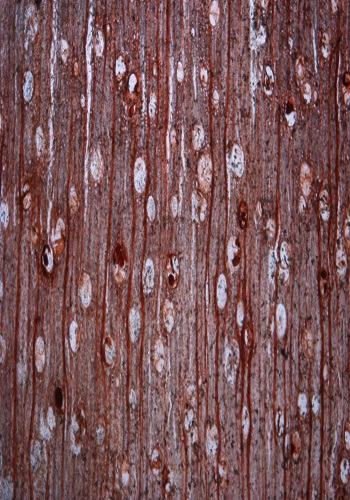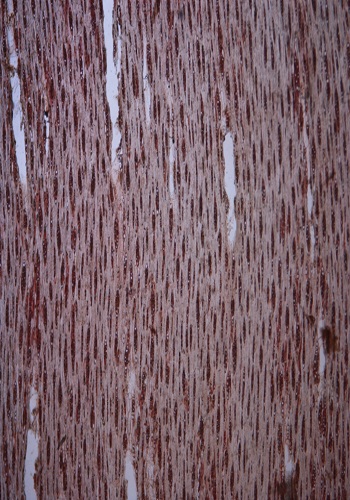The tree is native to Australia. It is widely planted in arid areas throughout the world. In Pakistan it is successfully planted throughout the plains and in the hills to an elevation of 1200m.
The heartwood is distinct from sapwood. The sapwood is light, grey and the heartwood is reddish-brown. The grain is wavy to interlocked, medium fine and somewhat even-textured.
The growth ring foundries are indistinct, the wood is diffuse-porous. The vessels are found in diagonal and/ or radial pattern, exclusively solitary (more than 90%), very small to large, 46.71-190.46 µ in diameter and 5-10/mm2 in number. The tyloses are commom.. The parenchyma is abundantly paratracheal, diffuse, diffuse-in-aggregate, scanty , vasicentric and unilateral. The wood rays are uni-seriate to tri-seriate 10-20/mm in cross section and 52.84-139.89, 1-3 cells(4.62-34.19µ) in width, 15-20 (37.27-276.7) cells in height. The fibers are libriform, non-septate, 0.72-1.76 mm long,7.28-24.37µ in diameter with1.21-4.66µ wall-thickness.
 |
 |
 |
| Cross view of Eucalyptus wood | Tangential view of Eucalyptus wood | Wood Fibers of Eucalyptus |
The wood of Eucalyptus is used in making of carriages, house and office furniture (after careful seasoning), shelterbelt, pulp and paper, and in fiber and particle board.
1. Dadswell, H.E. 1972. The Anatomy of Eucalypts Woods. Forest Products Laboratory, Division of Applied Chemistry Technological Paper No. 66.
2. Sheikh, M.I.1993. Trees of Pakistan. Pakistan Forest Institute, Peshawar.pp-65.
3. Siddiqui, K.M., M. Ayaz and I. Mahmood.1996. Properties and Uses of Pakistani Timbers. Pakistan Forest Institute, Peshawar. pp 65-66.